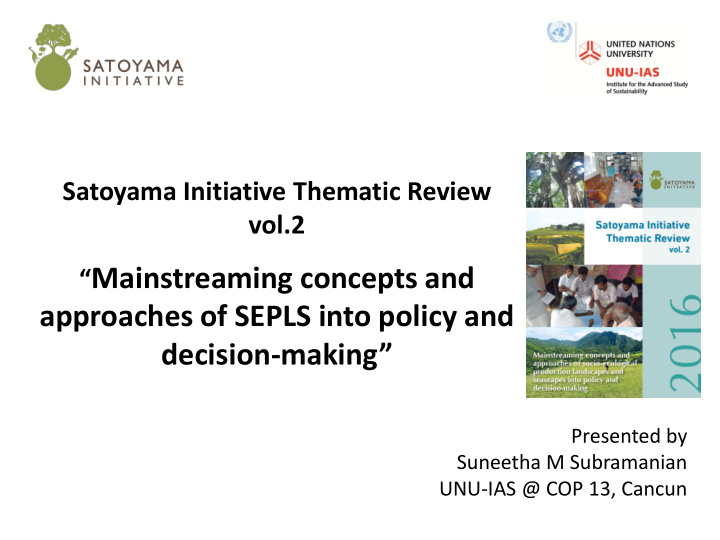



Satoyama Initiative Thematic Review vol.2 “ Mainstreaming concepts and approaches of SEPLS into policy and decision- making” Presented by Suneetha M Subramanian UNU-IAS @ COP 13, Cancun
Satoyama Initiative Thematic Review • A compilation of case studies from IPSI members on a specific issue in SEPLS – Vol. 1: Tools and approaches for enhancing knowledge for SEPLS management – Vol. 2 Mainstreaming concepts and approaches of SEPLS • Provide useful knowledge based on members’ on -the-ground activities • Make targeted contributions to policy and • IPSI Collaborative Activity (UNU-IAS academic discussions to encourage the and IGES) application of lessons learned in the field. • Initiated in 2015
Publication process • Developed through a multi-stage process • Provide feedback on papers among authors • In-depth discussion among authors Case Study Revision of Workshop: papers Review by - Feedback from Submission Publication other participants Synthesis authors - In-depth paper discussion on development the theme
Satoyama Initiative Thematic Review Vol 2 “Mainstreaming concepts and approaches of socio - ecological production landscape and seascapes into policy and decision- making” Larger-scale adoption of activities for SEPLS conservation – Replication of community level activities – Upscaling by incorporating into policy-planning and implementation processes
Case Studies Authors Sites Topic Policies and development interventions related to forest use Liu & Liu Yunnan, China and traditional knowledge (TFRK) Gualandi & Revitalization of ancient wheat varieties through Tuscany, Italy Gualandi coordinated links among producers, processors and others Kieninger et Wachau, Austria Policy tools and market mechanisms for cultural landscapes al conservation Hualien County, Tailoring of the concept of SEPLS in the planning of Lee et al Taiwan protected area planning Olupot & Mabira Central Evaluation of landscape values for ecotourism in a Reserve Isabirye- Forest Reserve, Forest area Basuta Uganda Kumar & Kerala, Action research and advocacy projects for agro-biodiversity, Prajeesh India livelihood improvement, and capacity building Pandit et al Four districts in Development LBSAPs and domestication of wild herb Nepal species
Various dimensions of mainstreaming activities • Focuses of the activities Biodiversity conservation, resource management, sectoral activities, poverty and livelihood, cultural aspects, social equity • Socio-economic contexts Demography, literacy, knowledge, values, adaptive capacity, institutions, economic activities, power structure, policy and planning, climate change, disasters • Relevant sectors Agriculture, forest, tourism, protected area, production and consumption, etc • Existing policy/institutional framework utilized NBSAP, protected area zoning and management plan, regional laws on use of local products; agricultural subsidies, local action groups, etc
Overarching principles for successful mainstreaming Mobilise knowledge towards action • Integrate traditional and modern scientific knowledge on management of SEPLS for appropriate pathways for their conservation under different social, political and economic contexts • Translate, transcribe and transform knowledge through inter- and trans- disciplinary approaches Foster and leverage inclusive participation • Foster a participatory approach to create a shared vision and identify composite or inter-linked goals that address multiple objectives • Foster “collective efficacy” through: – Building trust among stakeholders – Identifying relevant institutions and define roles – Engaging higher political systems and get feedback – Encouraging cross-learning among communities and stakeholders for development of capacities and to raise awareness Adaptive planning and management of activities • Establish long-term monitoring and periodic review • Make sure replication efforts are flexible
Thank you for your attention! Call for abstract for Thematic Review vol. 3 is now open!
Recommend
More recommend